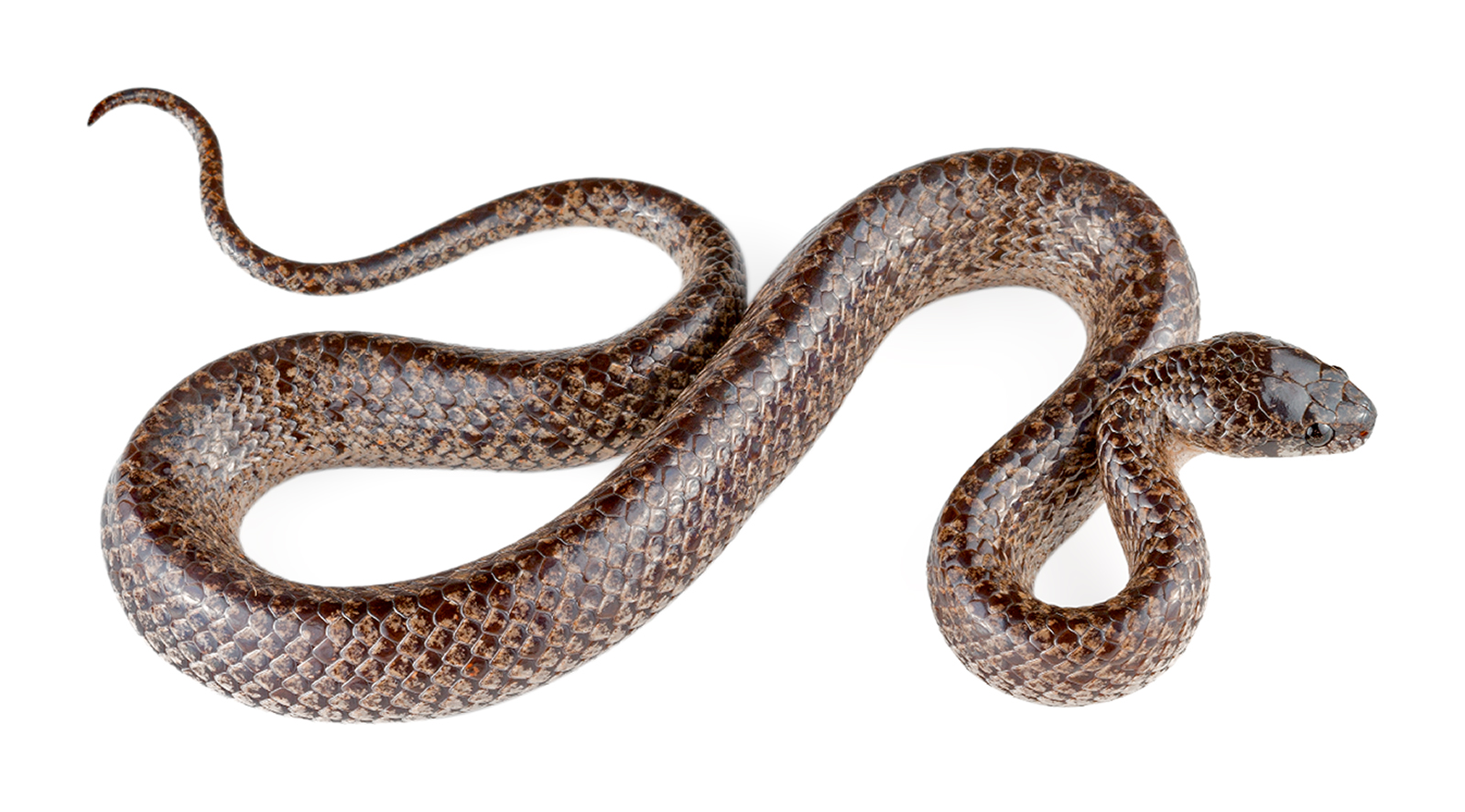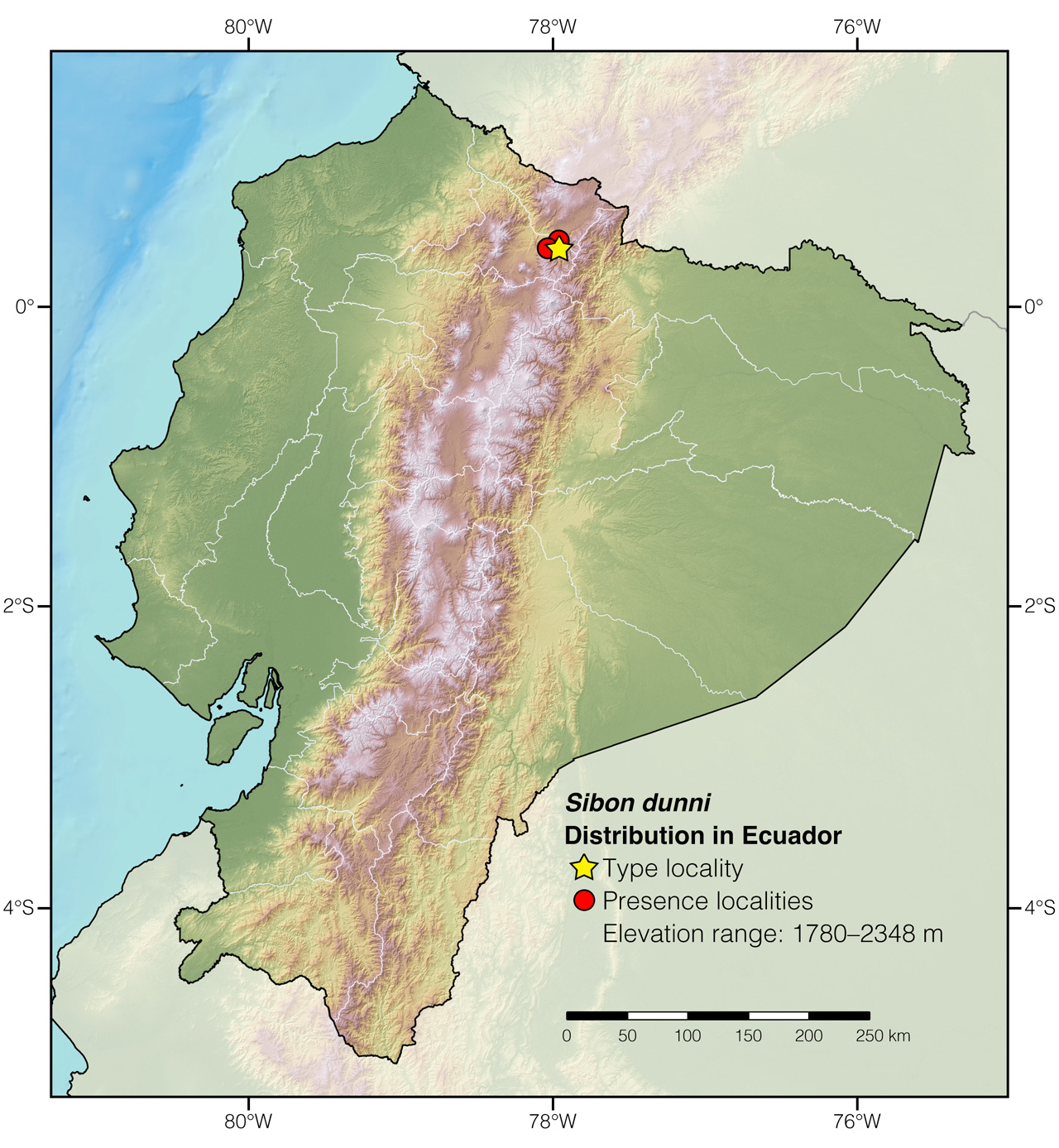Sandy Snail-Eater |
Reptiles of Ecuador | Serpentes | Colubridae | Sibon | Sibon dunni
English common names: Sandy Snail-Eater.
Spanish common names: Caracolera arenosa.
Recognition: ♂♂ 40.2 cm ♀♀ 23.9 cm. In its area of distribution, The Sandy Snail-Eater (Sibon dunni) is the only snake having the head much wider than the neck and a brownish dorsum lacking vertical bars. The Highland Snail-Eater (D. ellipsifera) also occurs in alongside S. dunni in some localities, but it has a pattern of vertical bars between which there is a more or less distinct narrow pale bar.
Picture: Adult from Pimampiro, Imbabura, Ecuador. | |
 | |
Natural history: Rare. Sibon dunni is a nocturnal snake that inhabits dry to humid highland shrublands and plantations.1 During the day, Sandy Snail-Eaters sleep coiled under rocks. Individuals of S. dunni are harmless to humans; they are extremely docile and never attempt to bite.1
Conservation: Critically Endangered. We consider Sibon dunni to be in this category, instead of Data Deficient,2 following IUCN criteria3 because the species’ extent of occurrence is estimated to be less than 100 km2, it is known from only two localities, and its habitat is severely fragmented and declining in extent and quality due to conversion of native shrublands to crops and human settlements.
Distribution: Sibon dunni is endemic to the inter-Andean valleys of northern Ecuador along the headwaters of the Río Mira in Imbabura province.

Etymology: The generic name Sibon is probably derived from the Latin word sibonis (a kind of “hunting spear”).4 It may refer to the shape of the head in this group of snakes. The specific epithet dunni honors American herpetologist Emmett Reid Dunn (1894–1956), in recognition of his contributions to expanding the knowledge on Neotropical reptiles and amphibians.
See it in the wild: Sibon dunni has only been reported nine times in Ecuador since 1934, making it one of the rarest snakes in the country. Almost all observations are from Pimampiro and surrounding areas.
FAQ
Are snail-eating snakes venomous? No, but some species have glands in the lower jaw which produce a mucous secretion that presumably causes paralysis and death of the mollusks they consume. This secretion also facilitates prey lubrication during ingestion.5
Do snails attract snakes? Yes. Snail-eating snakes follow snails visually or by tracking their scent trail.6
Do snail-eating snakes eat the shell of the snails? They don't. These snakes use specialized muscular contractions of their wedge-like head to extract snails from their shells.6
Author: Alejandro ArteagaaAffiliation: Fundación Khamai, Reserva Arlequín, Ecoruta Paseo del Quinde km 56, Santa Rosa de Mindo, Pichincha 171202, Ecuador.
Photographer: Alejandro ArteagaaAffiliation: Tropical Herping (TH), Quito, Ecuador.
How to cite? Arteaga A (2020) Sibon dunni. In: Arteaga A, Bustamante L, Vieira J (Eds) Reptiles of Ecuador: Life in the middle of the world. Available from: www.reptilesofecuador.com
Literature cited:
- Field notes, Reptiles of Ecuador book project.
- Cisneros-Heredia DF (2016) Sibon dunni. The IUCN Red List of threatened species. Available from: www.iucnredlist.org
- IUCN (2001) IUCN Red List categories and criteria: Version 3.1. IUCN Species Survival Commission, Gland and Cambridge, 30 pp.
- Lee JC (1996) The amphibians and reptiles of the Yucatán Peninsula. Comstock Publishing Associates, Ithaca, 500 pp.
- De Oliveira L, Jared C, da Costa Prudente AL, Zaher H, Antoniazzi MM (2008) Oral glands in dipsadine “goo-eater” snakes: morphology and histochemistry of the infralabial glands in Atractus reticulatus, Dipsas indica, and Sibynomorphus mikanii. Toxicon 51: 898–913.
- Sheehy C (2012) Phylogenetic relationships and feeding behavior of Neotropical snail-eating snakes (Dipsadinae, Dipsadini). PhD Thesis, UT Arlington.